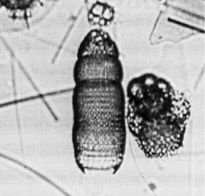 Phormostichoartus
corbula (Harting)
Phormostichoartus
corbula (Harting) Phormostichoartus
corbula (Harting)
Phormostichoartus
corbula (Harting)Lithocampe corbula Harting, 1863, p.12, pl.1, fig.21
Phormostichoartus corbula (Harting), Nigrini, 1977, p.252, pl.1, fig.10 (with synonymy)
Shell thin-walled, smooth, subcylindrical consisting of 4 segments of which the fourth is the broadest. Cephalis approximately spherical with a well-developed, poreless, [vertical] tubule that curves downwards so as to lie close to the thorax; numerous subcircular pores; no apical horn. Collar stricture indistinct.
Thorax short, truncate conical, with circular to subcircular pores arranged approximately in transverse rows. Lumbar and post-lumbar strictures distinct.
Abdomen annular, somewhat longer than thorax. Pores small, subcircular to squarish, arranged in 5-8 regular closely spaced transverse rows.
Fourth segment 2-4 times as long as abdomen; pores similar in size and shape to those on abdomen, in 9-17 transverse rows. Segment tapers slightly distally and ends in a generally poreless peristome. Termination smooth [or, sometimes, small, pointed teeth are present] (Nigrini, 1967).
Total length 130-165 µm maximum breadth 65-75 µm. Measurements given by Nigrini (1967) have a greater range for both length and breadth (Nigrini, 1977).
Four-segmented form, the last segment being the longest. All postcollar strictures are distinct but not deep. Pores small, regularly arranged in dense transverse rows. Distinct poreless peristome somewhat constricted (Riedel and Sanfilippo, 1978a, as Siphocampe corbula).
P. corbula differs from P. fistula Nigrini (1977, p.453, pl.1, figs.11-13) in having smaller pores, usually more than twelve pores across the fourth segment in 9-17 rows, as compared to less than eight across in 5-8 rows in P. fistula (Sanfilippo et al., 1985).
This four-segmented artostrobiid has a well-developed poreless cephalic tube that curves downward along the thorax. The length of the fourth segment varies from one to four times the length of the third (Sanfilippo et al., 1985).
This middle middle Miocene through Quaternary species is found in latitudes less than 40°, except for DSDP Site 206 near New Zealand and Site 362 off southwest Africa. Its morphotypic first appearance lies within the Dorcadospyris alata Zone. It is extant.
P. corbula may have evolved from P. fistula, and is extant.
Additional illustrations can be found in Riedel and Sanfilippo, 1971, pl.1H, figs.18-25.